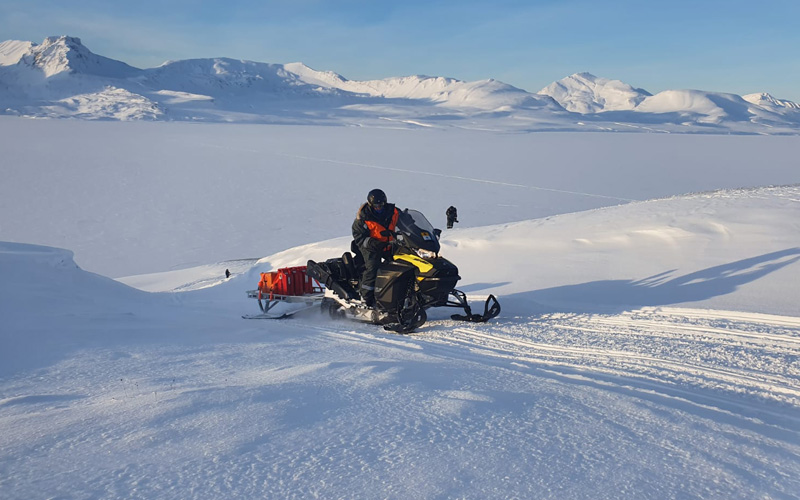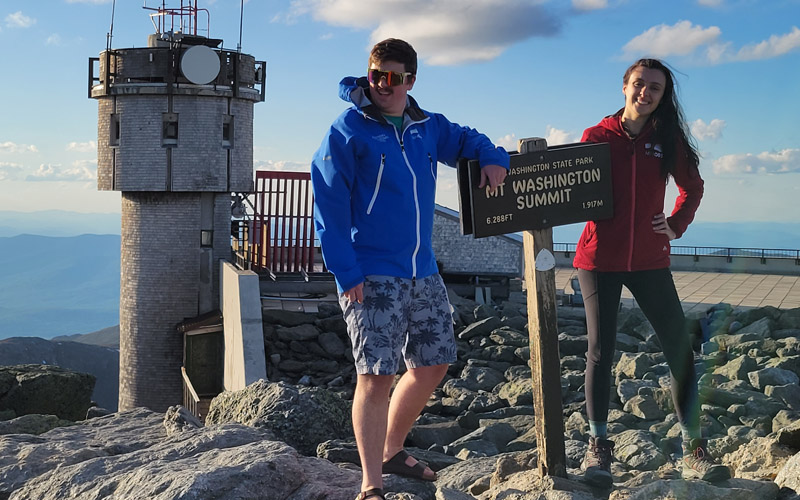2022 Seek the Peak Photos
2022 Seek the Peak Photos
2022-07-20 10:40:15.000 – MWOBS Staff, Contributed photos.

 Pack fitting was offered at the EMS and Backpacker Magazine booths.
Pack fitting was offered at the EMS and Backpacker Magazine booths. EMS field experts get ready for the expo to open.
EMS field experts get ready for the expo to open. Seek the Peak hikers enjoy views from the Observation tower during a tour of our summit weather station.
Seek the Peak hikers enjoy views from the Observation tower during a tour of our summit weather station. Seek the Peak team ‘The Seekers’ are shown atop Blueberry Mountain.
Seek the Peak team ‘The Seekers’ are shown atop Blueberry Mountain. 
 Carrie Slife of MWOBS visits with Mel Elam and her cat Flokie at Tuckerman Brewing Co. Friday night at the Seek the Peak kick-off party. Mel and Flokie have summited all of New Hampshire’s 4,000 footers together.
Carrie Slife of MWOBS visits with Mel Elam and her cat Flokie at Tuckerman Brewing Co. Friday night at the Seek the Peak kick-off party. Mel and Flokie have summited all of New Hampshire’s 4,000 footers together. Seek the Peak hikers visit the Backpacker Get Out More Tour booth. EMS photo.
Seek the Peak hikers visit the Backpacker Get Out More Tour booth. EMS photo. Randy Propster of Backpacker helps a visitor with pack fitting.
Randy Propster of Backpacker helps a visitor with pack fitting.  The Bear Mountain Band performs at the expo.
The Bear Mountain Band performs at the expo. Cotopaxi brought tons of color to the expo. EMS photo.
Cotopaxi brought tons of color to the expo. EMS photo. The gear giveaway.
The gear giveaway. Hyperlite Mountain Gear was one of our 2022 sponsors.
Hyperlite Mountain Gear was one of our 2022 sponsors. Granite Backcountry Alliance was one of our sponsors. EMS photo.
Granite Backcountry Alliance was one of our sponsors. EMS photo. Visitors learn about our weather and climate work in the White Mountains at the MWOBS booth.
Visitors learn about our weather and climate work in the White Mountains at the MWOBS booth. Randy Propster of Backpacker and Carrie Slife of MWOBS pull raffle tickets as the gear giveaway begins.
Randy Propster of Backpacker and Carrie Slife of MWOBS pull raffle tickets as the gear giveaway begins. A MWOBS parking volunteer greets the camera enthusiastically by the food trucks.
A MWOBS parking volunteer greets the camera enthusiastically by the food trucks. An expo visitor enjoys music performed by the Bear Mountain Band. EMS photo.
An expo visitor enjoys music performed by the Bear Mountain Band. EMS photo.
MWOBS Staff, Contributed photos.



 Hayden Pearson driving to fieldwork in central Spitsbergen. Image taken by fellow researcher Cody Barnett.
Hayden Pearson driving to fieldwork in central Spitsbergen. Image taken by fellow researcher Cody Barnett. Ski touring in Svalbard. Image taken by fellow researcher Joe Buckby.
Ski touring in Svalbard. Image taken by fellow researcher Joe Buckby. Hayden Pearson and Jackie Bellefontaine, both Weather Observers/Education Specialists (UMaine alums taking over the summit!).
Hayden Pearson and Jackie Bellefontaine, both Weather Observers/Education Specialists (UMaine alums taking over the summit!). Sunrise from the summit on 19 May 2022
Sunrise from the summit on 19 May 2022
 Henry Moskovitz
Henry Moskovitz
 A range of the anemometers designed and used during the Observatory’s history, shown above clockwise from top left, include the Heated No. 2, Grandfather Pitot, Pitot 92, Pitot 94, Pitot 97, Pitot 11, and Pitot 19.
A range of the anemometers designed and used during the Observatory’s history, shown above clockwise from top left, include the Heated No. 2, Grandfather Pitot, Pitot 92, Pitot 94, Pitot 97, Pitot 11, and Pitot 19.
 An RM Young propeller-driven anemometer.
An RM Young propeller-driven anemometer.  The Pitot 22 Anemometer.
The Pitot 22 Anemometer.  Weather Observer and Meteorologist Jay Broccolo keeps an eye on blading from the snow cat cabin window during an early March trip to the summit for our weekly shift change.
Weather Observer and Meteorologist Jay Broccolo keeps an eye on blading from the snow cat cabin window during an early March trip to the summit for our weekly shift change.
 Observatory staff and guests from WBZ CBS Boston walk along the along the Mount Washington Auto Road as the snowcat clears the way
Observatory staff and guests from WBZ CBS Boston walk along the along the Mount Washington Auto Road as the snowcat clears the way The snowcat traveling up the auto road on a bluebird day.
The snowcat traveling up the auto road on a bluebird day.  The snowcat loaded up with gear outside of the NH State Parks’ Sherman Adams Summit Building.
The snowcat loaded up with gear outside of the NH State Parks’ Sherman Adams Summit Building. 


 Rime ice forming on rocks.
Rime ice forming on rocks. Rime ice forming on a grade stake along the Mount Washington Auto Road.
Rime ice forming on a grade stake along the Mount Washington Auto Road.
 Rime ice on the RM Young anemometer.
Rime ice on the RM Young anemometer. Rime ice is visible looking out our weather room window.
Rime ice is visible looking out our weather room window.  Hoar frost on a temperature sensor.
Hoar frost on a temperature sensor.